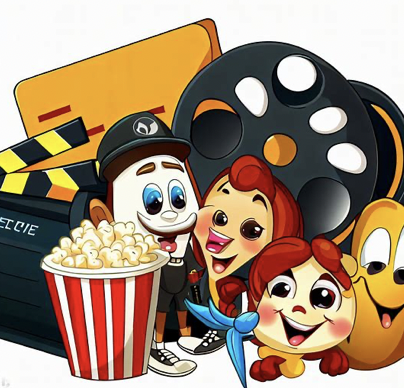In filmmaking, there are numerous tools and equipment that play a role in ensuring the smooth execution of a movie.
One such tool that has become synonymous with the film industry is the clapperboard.
Often seen in behind-the-scenes footage or during the making of movies, the clapperboard serves multiple purposes and is an essential part of the filmmaking process.
What Is a Clapperboard?
A clapperboard, also known as a clapboard, slate, or film clapper, is a device used in filmmaking and video production to assist in the synchronizing of picture and sound, and to designate and mark specific scenes and takes recorded during a production.
It consists of a black-and-white board and a hinged stick which is “clapped” to provide a visual and auditory cue for the syncing of sound and image in post-production.
We look in more detail below at clapperboards, exploring their history, functions, and significance in the movie industry.
Table of Contents
The History of Clapperboards
The clapperboard, also known as a slate, has a long and fascinating history that dates back to the early days of cinema.
Before the advent of synchronized sound, filmmakers faced the challenge of matching audio with visual footage.
This led to the development of the clapperboard, which provided a visual and audible cue to synchronize sound and image during post-production.
The first clapperboards were simple wooden slates with basic information written on them.
As technology advanced, clapperboards evolved to include features such as a hinged clapstick and a surface for writing additional details about the scene being filmed.
Today, clapperboards come in various shapes and sizes, with digital versions also available.
The Functions of a Clapperboard
A clapperboard serves several important functions on a movie set. Let’s explore some of its key roles:
1. Scene Identification
The primary function of a clapperboard is to identify and label each scene being filmed.
The information written on the clapperboard includes the production title, scene number, take number, and other relevant details.
This helps in organizing and cataloging footage during post-production.
2. Synchronization of Sound and Image
As mentioned earlier, clapperboards play a crucial role in synchronizing sound and image.
The clapstick, which is the hinged part of the clapperboard, produces a distinctive sound when closed.
This sound serves as a reference point for aligning the audio recorded separately with the corresponding visual footage.
3. Marker for Editors
Clapperboards provide a visual marker for editors to identify the beginning and end of each take.
The clapstick is held in front of the camera and then closed, creating a clear visual and audible cue.
This helps editors locate specific scenes quickly and efficiently during the post-production process.
4. Continuity and Accuracy
Clapperboards assist in maintaining continuity and accuracy throughout the filming process.
By clearly indicating the scene and take numbers, clapperboards ensure that the footage is organized and sequenced correctly.
This is particularly important when shooting scenes out of order or when multiple takes are required.
Types of Clapperboards
Over the years, clapperboards have evolved to cater to different filming needs. Here are some common types of clapperboards:
1. Traditional Clapperboard
The traditional clapperboard consists of a hinged clapstick attached to a rectangular board.
The board typically has sections for writing scene information, take numbers, and other relevant details. This type of clapperboard is widely used in the film industry.
2. Digital Clapperboard
With advancements in technology, digital clapperboards have gained popularity.
These clapperboards feature an electronic display that can be customized to show various information, including scene details, take numbers, and even the timecode.
Digital clapperboards offer the advantage of easy editing and customization.
3. Mini Clapperboard
Mini clapperboards, also known as slate keychains, are smaller versions of traditional clapperboards.
They are often used as novelty items or gifts for film enthusiasts.
While they may not serve the same practical purpose as their larger counterparts, mini clapperboards are a fun way to show appreciation for the film industry.
Case Study: The Importance of Clapperboards in Film Production
To further understand the significance of clapperboards in film production, let’s take a look at a case study:
Movie X: Streamlining Post-Production
Movie X, a highly anticipated action film, had a complex production schedule with multiple locations and intricate action sequences.
The production team recognized the importance of accurate scene identification and synchronization of sound and image to streamline the post-production process.
By utilizing clapperboards, the team ensured that each scene was properly labeled and organized.
The clapstick’s distinctive sound helped synchronize the audio recorded separately with the corresponding visual footage, saving valuable time during post-production.
Editors working on Movie X praised the use of clapperboards for their efficiency in locating specific scenes.
The clear visual and audible cues provided by the clapperboards allowed editors to navigate through the footage seamlessly, resulting in a smooth post-production workflow.
FAQs – Movie Action Thing – What Is a Clapperboard?
1. What is the purpose of a clapperboard?
A clapperboard serves multiple purposes on a movie set, including scene identification, synchronization of sound and image, and providing a visual marker for editors.
2. How does a clapperboard synchronize sound and image?
The clapstick of a clapperboard produces a distinctive sound when closed.
This sound serves as a reference point for aligning the separately recorded audio with the corresponding visual footage.
3. Can clapperboards be customized?
Yes, clapperboards can be customized, especially digital versions.
Digital clapperboards offer the advantage of easy editing and customization of the displayed information.
4. Are clapperboards only used in the film industry?
While clapperboards are primarily associated with the film industry, they can also be used in other areas that require synchronization of audio and visual elements, such as television production or documentary filmmaking.
5. Do all movies use clapperboards?
While not all movies use clapperboards, they are widely used in professional film productions to ensure accurate scene identification and synchronization of sound and image.
6. Are there any alternatives to clapperboards?
While clapperboards are the most common tool for scene identification and synchronization, some filmmakers may use alternative methods such as hand claps or digital timecode systems.
7. Can clapperboards be used in live performances?
Clapperboards are primarily designed for recorded productions, but they can be used in live performances as a visual cue for performers or technicians.
8. How do clapperboards help with continuity in filmmaking?
Clapperboards assist in maintaining continuity by clearly indicating the scene and take numbers.
This ensures that the footage is organized and sequenced correctly, even when shooting scenes out of order or requiring multiple takes.
9. Are clapperboards used in animated movies?
While clapperboards may not be used during the actual animation process, they can still be utilized during the pre-production and post-production stages of animated movies for scene identification and synchronization purposes.
10. Can clapperboards be used in low-budget productions?
Yes, clapperboards can be used in low-budget productions as they are relatively affordable and provide essential functions for organizing footage and synchronizing sound and image.
11. Are there any famous clapperboard scenes in movies?
Yes, there are several iconic movie scenes that feature clapperboards, such as the opening sequence of “The Shining” where the clapperboard is prominently shown, adding to the suspense of the film.
12. How do digital clapperboards differ from traditional ones?
Digital clapperboards feature an electronic display that can be customized to show various information, including scene details, take numbers, and timecode.
They offer the advantage of easy editing and customization compared to traditional clapperboards.
13. Can clapperboards be used in documentary filmmaking?
Yes, clapperboards can be used in documentary filmmaking to aid in scene identification and synchronization, especially when recording interviews or reenactments.
14. Are there any safety precautions when using clapperboards?
While clapperboards are generally safe to use, it is important to handle them with care to avoid any injuries.
The clapstick should be closed gently to prevent any accidents or damage to the equipment.
15. Can clapperboards be used in post-production if they were not used during filming?
Clapperboards are primarily used during filming to provide visual and audible cues for synchronization.
If clapperboards were not used during filming, it may be challenging to accurately synchronize sound and image during post-production.
Summary – Movie Action Thing – What Is a Clapperboard?
Clapperboards have been an integral part of the filmmaking process for decades.
They serve multiple functions, including scene identification, synchronization of sound and image, and marker for editors.
Clapperboards ensure continuity and accuracy throughout the filming process and streamline post-production workflows.
With various types available, including traditional and digital clapperboards, these tools continue to play a vital role in the movie industry.


